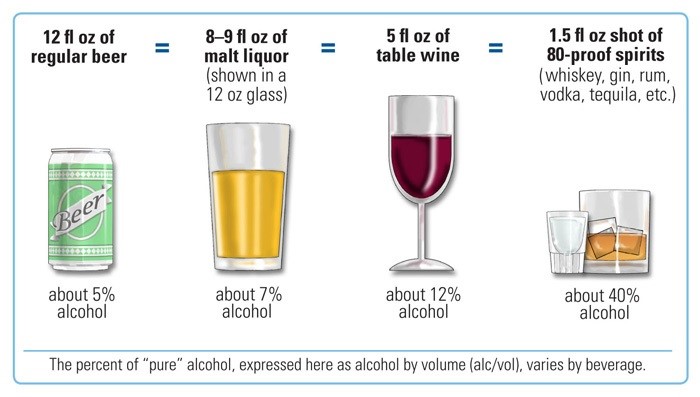By Avance Care’s Registered Dietitian: Shannon Corlett, MS, RDN, LDN
Over the past several centuries a debate on the risks and benefits of alcohol consumption has captured the interest of scientists around the world. More recently, the media and general public have also become involved. With headlines from “Cheers! Alcohol IS good for you: Up to 5 drinks each week lowers risk of heart failure and heart attack” to “One Alcoholic Drink a Day Could Raise Heart Disease Risk” popping up in our newspapers, it remains unclear whether alcohol is the hero or the villain in modern society. As individuals become increasingly interested in the impact of their dietary choices on health and longevity, concern for appropriate alcohol intake cannot be neglected. Unfortunately, as with all good debates, there is no obvious winner when it comes to drinking. A moderate amount of alcohol may reduce your risk of heart disease and overall risk of mortality, but too much may increase your risk for some head and neck cancers, stroke, and breast cancer.
Potential Risk Reductions of Moderate Alcohol Use
· 8% decreased risk of having an ischemic (blood clot) stroke
· 13% decreased risk of dying from any cause
· 25% decreased risk of dying from cardiovascular disease
· 30% decreased risk developing Type 2 Diabetes Mellitus (note that this improvement is not seen with heavy drinking)
Potential Risks of Moderate to Heavy Alcohol Use
· 6% increased risk of dying from a stroke
· 14% risk of having a hemorrhagic (bleeding) stroke
· 41% increased risk of developing breast cancer in women (2 or more drinks/day- But even 1 drink will increase your risk!)
· 62% increased risk of having a stroke (4 or more drinks/ day)
· 2-3X increased risk of developing cancers of the oral cavity (excluding the lips), pharynx, and larynx (3.5 or more drinks per day)
Not a Red Wine Drinker? Not a Problem.
There’s no concrete evidence that red wine is better for you than other forms of alcohol, but there is significant speculation about how this drink could be protecting your heart. The antioxidant and anti-inflammatory effects of polyphenols (resveratrol) in red wine are thought to protect against atherogenesis, the formation of fatty masses along the interior of artery walls. However, all alcohol (beer, wine, and spirits) is thought to be cardioprotective by increasing levels of “good cholesterol” (high density lipoprotein- HDL) and the hormone adiponectin, which has beneficial effects on blood sugar and the breakdown of fats. Alcohol is also thought to reduce fibrinogen, a protein that helps form blood clots. However, these improvements are lost and metabolic syndrome worsens with heavy alcohol consumption.
When it comes to the risks and benefits of drinking alcohol, the difference is in the dose. Compared to non-drinkers, people who consume moderate amounts of alcohol have an initial reduction in mortality, but beyond this initial decrease, the more you drink the greater your risk becomes. So where’s the “sweet spot” with the lowest risk of mortality? Around 0.5-1 drink per day. However, this protective effect, where the risk of mortality is below that of non-drinkers, is thought to extend up to two drinks a day for women and three drinks per day for men.
What Does It Mean to ‘Drink in Moderation?’
One of the major distinctions almost every study that touts the benefits of alcohol makes is that the amount consumed cannot be ‘in excess.’ In the United States, moderate drinking has been defined as no more than 1 standard drink per day for women and no more than 2 standard drinks per day for men. Unfortunately, it’s unlikely that the glass of wine you were poured at dinner last weekend fits the 5-ounce definition for a standard drink (it was more likely 8-9 ounces!). Consuming alcohol at or below these recommendations is the safest way to obtain the potential benefits of drinking while also minimizing the potential risks.
Definition of a Standard Drink
How the Empty Calories from Alcohol Can Sabotage Weight Loss Goals
Alcohol contains 7 calories per gram- That’s even more energy than carbohydrates or protein! If you are trying to lose weight, alcohol can have a devastating effect on your caloric intake for the day. Here are the approximate energy contributions from some common beverages:
· Regular Beer: 153 calories/12 oz serving
· Light Beer: 103 calories/12 oz serving
· Red Wine: 125 calories/5 oz serving
· White Wine: 121 calories/5 oz serving
· Rum/Vodka/Whiskey/Tequila (80 proof): 97 calories/1.5 oz serving
o But don’t forget your mixers…. One 9 ounce Pina Colada contains an average of 490 calories!
The Bottom Line
If you don’t currently drink, don’t start. If you do currently drink, do so in moderation and try not to drink on an empty stomach. What you drink (beer, wine, or spirits) does not seem to be as important as how you drink it. Having five drinks on a weekend night is not the same as having one with dinner each day, even though the weekly total may be the same. Both heavy drinking and binge drinking can be damaging to your health and no beneficial effects have been found above three drinks a day. For maximum benefit, stick to the recommended limit of one drink a day for women and two drinks a day for men and focus on developing an overall healthy diet and lifestyle.
Resources:
http://www.health.harvard.edu/heart-health/more-to-the-story-than-alcohol–heart-protection
http://www.bmj.com/bmj/section-pdf/186224/8
http://rethinkingdrinking.niaaa.nih.gov/Tools/Calculators/Calorie-Calculator.aspx
http://www.ncbi.nlm.nih.gov/pubmed/15735217
http://www.hsph.harvard.edu/nutritionsource/alcohol-full-story/#possible_health_benefits

